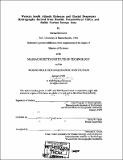Western South Atlantic holocene and glacial deepwater hydrography derived from benthic foraminiferal Cd/Ca and stable carbon isotope data
Author(s)
Horowitz, Michael (Michael Joshua), 1962-
DownloadFull printable version (2.897Mb)
Other Contributors
Woods Hole Oceanographic Institution.
Advisor
Delia W. Oppo.
Terms of use
Metadata
Show full item recordAbstract
Today, deep waters produced in the North Atlantic are exported through the western South Atlantic. Antarctic intermediate water (AAIW) also enters the Atlantic in this region. Circumpolar deep water (CDW) fills the depths below AAIW and above and below northern source waters. A depth transect of cores from 1567-3909 m water depth in the western South Atlantic are ideally located to monitor inter-ocean exchange of deep water, and variations in the relative strength of northern versus southern source water production. Last glacial maximum (LGM) Cd/Ca and 813C data indicate a nutrient-depleted intermediate-depth water mass. In the mid-depth western South Atlantic, a simple conversion of LGM 813C data suggests significantly less nutrient enrichment than LGM Cd/Ca ratios, but Cd/Ca and 613C data can be reconciled when plotted in CdW/ 13C space. Paired LGM Cd/Ca and S13C data from mid-depth cores suggest increasingly nutrient rich waters below 2000 m, but do not require an increase in Southern Ocean water contribution relative to today. Cd/Ca data suggest no glacial-interglacial change in the hydrography of the deepest waters of the region. To maintain relatively low Cd/Ca ratios (low nutrients) in the deepest western South Atlantic waters, and in CDW in general, during the LGM requires an increased supply of nutrient-depleted glacial North Atlantic intermediate water (GNAIW) and/or nutrient-depleted glacial Subantarctic surface waters to CDW to balance reduced NADW contribution to CDW. LGM Cd/Ca and 513C data suggest strong GNAIW influence in the western South Atlantic which in turn implies export of GNAIW from the Atlantic, and entrainment of GNAIW into the Antarctic Circumpolar current.
Description
Thesis (S.M.)--Joint Program in Oceanography (Massachusetts Institute of Technology, Dept. of Earth, Atmospheric, and Planetary Sciences; and the Woods Hole Oceanographic Institution), 1999. Includes bibliographical references (leaves 16-21).
Date issued
1999Department
Joint Program in Oceanography; Woods Hole Oceanographic Institution; Massachusetts Institute of Technology. Department of Earth, Atmospheric, and Planetary SciencesPublisher
Massachusetts Institute of Technology
Keywords
Joint Program in Oceanography., Earth, Atmospheric, and Planetary Sciences., Woods Hole Oceanographic Institution.